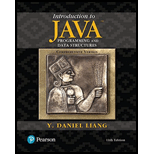
Introduction to Java Programming and Data Structures, Comprehensive Version (11th Edition)
11th Edition
ISBN: 9780134670942
Author: Y. Daniel Liang
Publisher: PEARSON
expand_more
expand_more
format_list_bulleted
Concept explainers
Question
Chapter 28.2, Problem 28.2.3CP
Program Plan Intro
Complete Graph:
In a graph, each pair of vertices is connected by an undirected edge is referred as complete graph. In complete graph, vertices is denoted kn and it has n(n-1)/2 edges. Hence, this graph is also referred as “Universal graph”.
Expert Solution & Answer
Want to see the full answer?
Check out a sample textbook solution
Students have asked these similar questions
Write the SQL code that permits to implement the tables: Student and Transcript. NB: Add the constraints on the attributes – keys and other.
Draw an ERD that will involve the entity types: Professor, Student, Department and Course. Be sure to add relationship types, key attributes, attributes and multiplicity on the ERD.
Draw an ERD that represents a book in a library system. Be sure to add relationship types, key attributes, attributes and multiplicity on the ERD.
Chapter 28 Solutions
Introduction to Java Programming and Data Structures, Comprehensive Version (11th Edition)
Ch. 28.2 - What is the famous Seven Bridges of Knigsberg...Ch. 28.2 - Prob. 28.2.2CPCh. 28.2 - Prob. 28.2.3CPCh. 28.2 - Prob. 28.2.4CPCh. 28.3 - Prob. 28.3.1CPCh. 28.3 - Prob. 28.3.2CPCh. 28.4 - Prob. 28.4.1CPCh. 28.4 - Prob. 28.4.2CPCh. 28.4 - Show the output of the following code: public...Ch. 28.4 - Prob. 28.4.4CP
Ch. 28.5 - Prob. 28.5.2CPCh. 28.6 - Prob. 28.6.1CPCh. 28.6 - Prob. 28.6.2CPCh. 28.7 - Prob. 28.7.1CPCh. 28.7 - Prob. 28.7.2CPCh. 28.7 - Prob. 28.7.3CPCh. 28.7 - Prob. 28.7.4CPCh. 28.7 - Prob. 28.7.5CPCh. 28.8 - Prob. 28.8.1CPCh. 28.8 - When you click the mouse inside a circle, does the...Ch. 28.8 - Prob. 28.8.3CPCh. 28.9 - Prob. 28.9.1CPCh. 28.9 - Prob. 28.9.2CPCh. 28.9 - Prob. 28.9.3CPCh. 28.9 - Prob. 28.9.4CPCh. 28.10 - Prob. 28.10.1CPCh. 28.10 - Prob. 28.10.2CPCh. 28.10 - Prob. 28.10.3CPCh. 28.10 - If lines 26 and 27 are swapped in Listing 28.13,...Ch. 28 - Prob. 28.1PECh. 28 - (Create a file for a graph) Modify Listing 28.2,...Ch. 28 - Prob. 28.3PECh. 28 - Prob. 28.4PECh. 28 - (Detect cycles) Define a new class named...Ch. 28 - Prob. 28.7PECh. 28 - Prob. 28.8PECh. 28 - Prob. 28.9PECh. 28 - Prob. 28.10PECh. 28 - (Revise Listing 28.14, NineTail.java) The program...Ch. 28 - (Variation of the nine tails problem) In the nine...Ch. 28 - (4 4 16 tails problem) Listing 28.14,...Ch. 28 - (4 4 16 tails analysis) The nine tails problem in...Ch. 28 - (4 4 16 tails GUI) Rewrite Programming Exercise...Ch. 28 - Prob. 28.16PECh. 28 - Prob. 28.17PECh. 28 - Prob. 28.19PECh. 28 - (Display a graph) Write a program that reads a...Ch. 28 - Prob. 28.21PECh. 28 - Prob. 28.22PECh. 28 - (Connected rectangles) Listing 28.10,...Ch. 28 - Prob. 28.24PECh. 28 - (Implement remove(V v)) Modify Listing 28.4,...Ch. 28 - (Implement remove(int u, int v)) Modify Listing...
Knowledge Booster
Learn more about
Need a deep-dive on the concept behind this application? Look no further. Learn more about this topic, computer-science and related others by exploring similar questions and additional content below.Similar questions
- 2:21 m Ο 21% AlmaNet WE ARE HIRING Experienced Freshers Salesforce Platform Developer APPLY NOW SEND YOUR CV: Email: hr.almanet@gmail.com Contact: +91 6264643660 Visit: www.almanet.in Locations: India, USA, UK, Vietnam (Remote & Hybrid Options Available)arrow_forwardProvide a detailed explanation of the architecture on the diagramarrow_forwardhello please explain the architecture in the diagram below. thanks youarrow_forward
- Complete the JavaScript function addPixels () to calculate the sum of pixelAmount and the given element's cssProperty value, and return the new "px" value. Ex: If helloElem's width is 150px, then calling addPixels (hello Elem, "width", 50) should return 150px + 50px = "200px". SHOW EXPECTED HTML JavaScript 1 function addPixels (element, cssProperty, pixelAmount) { 2 3 /* Your solution goes here *1 4 } 5 6 const helloElem = document.querySelector("# helloMessage"); 7 const newVal = addPixels (helloElem, "width", 50); 8 helloElem.style.setProperty("width", newVal); [arrow_forwardSolve in MATLABarrow_forwardHello please look at the attached picture. I need an detailed explanation of the architecturearrow_forward
- Information Security Risk and Vulnerability Assessment 1- Which TCP/IP protocol is used to convert the IP address to the Mac address? Explain 2-What popular switch feature allows you to create communication boundaries between systems connected to the switch3- what types of vulnerability directly related to the programmer of the software?4- Who ensures the entity implements appropriate security controls to protect an asset? Please do not use AI and add refrencearrow_forwardFind the voltage V0 across the 4K resistor using the mesh method or nodal analysis. Note: I have already simulated it and the value it should give is -1.714Varrow_forwardResolver por superposicionarrow_forward
- Describe three (3) Multiplexing techniques common for fiber optic linksarrow_forwardCould you help me to know features of the following concepts: - commercial CA - memory integrity - WMI filterarrow_forwardBriefly describe the issues involved in using ATM technology in Local Area Networksarrow_forward
arrow_back_ios
SEE MORE QUESTIONS
arrow_forward_ios
Recommended textbooks for you
 Principles of Information Systems (MindTap Course...Computer ScienceISBN:9781285867168Author:Ralph Stair, George ReynoldsPublisher:Cengage Learning
Principles of Information Systems (MindTap Course...Computer ScienceISBN:9781285867168Author:Ralph Stair, George ReynoldsPublisher:Cengage Learning New Perspectives on HTML5, CSS3, and JavaScriptComputer ScienceISBN:9781305503922Author:Patrick M. CareyPublisher:Cengage Learning
New Perspectives on HTML5, CSS3, and JavaScriptComputer ScienceISBN:9781305503922Author:Patrick M. CareyPublisher:Cengage Learning EBK JAVA PROGRAMMINGComputer ScienceISBN:9781337671385Author:FARRELLPublisher:CENGAGE LEARNING - CONSIGNMENT
EBK JAVA PROGRAMMINGComputer ScienceISBN:9781337671385Author:FARRELLPublisher:CENGAGE LEARNING - CONSIGNMENT Fundamentals of Information SystemsComputer ScienceISBN:9781305082168Author:Ralph Stair, George ReynoldsPublisher:Cengage Learning
Fundamentals of Information SystemsComputer ScienceISBN:9781305082168Author:Ralph Stair, George ReynoldsPublisher:Cengage Learning Operations Research : Applications and AlgorithmsComputer ScienceISBN:9780534380588Author:Wayne L. WinstonPublisher:Brooks Cole
Operations Research : Applications and AlgorithmsComputer ScienceISBN:9780534380588Author:Wayne L. WinstonPublisher:Brooks Cole


Principles of Information Systems (MindTap Course...
Computer Science
ISBN:9781285867168
Author:Ralph Stair, George Reynolds
Publisher:Cengage Learning

New Perspectives on HTML5, CSS3, and JavaScript
Computer Science
ISBN:9781305503922
Author:Patrick M. Carey
Publisher:Cengage Learning

EBK JAVA PROGRAMMING
Computer Science
ISBN:9781337671385
Author:FARRELL
Publisher:CENGAGE LEARNING - CONSIGNMENT

Fundamentals of Information Systems
Computer Science
ISBN:9781305082168
Author:Ralph Stair, George Reynolds
Publisher:Cengage Learning

Operations Research : Applications and Algorithms
Computer Science
ISBN:9780534380588
Author:Wayne L. Winston
Publisher:Brooks Cole